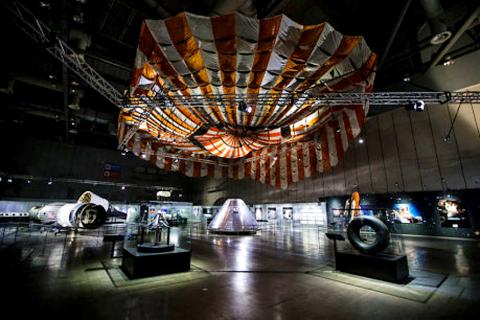NASA — A Human Adventure exhibition tells an inspiring story of NASA’s remarkable accomplishments in manned space flights and space exploration since humans first landed on the moon in 1969. The exhibition shows almost 300 historically significant artifacts from the US and Soviet Union space programs — many of which have come back from space.
The exhibition is broken down into seven themes, the highlights of which are Go Fever, which examines the tensions that led to the space race during the cold war, and Endurance, which examines how astronauts survive in space (space suits and space food).
Most of the artifacts are on loan from the Kansas Cosmosphere & Space Center and the US Space & Rocket Center.

Photo courtesy of NASA – A Human Adventure
■ National Taiwan Science Education Center (國立台灣科學教育館), 189 Shishang Rd, Taipei City (台北市士商路189號)
■ Admission is NT$380. Open daily from 9am to 5pm. Ends Sept. 18. For more information: space-event.com.tw

June 2 to June 8 Taiwan’s woodcutters believe that if they see even one speck of red in their cooked rice, no matter how small, an accident is going to happen. Peng Chin-tian (彭錦田) swears that this has proven to be true at every stop during his decades-long career in the logging industry. Along with mining, timber harvesting was once considered the most dangerous profession in Taiwan. Not only were mishaps common during all stages of processing, it was difficult to transport the injured to get medical treatment. Many died during the arduous journey. Peng recounts some of his accidents in

“Why does Taiwan identity decline?”a group of researchers lead by University of Nevada political scientist Austin Wang (王宏恩) asked in a recent paper. After all, it is not difficult to explain the rise in Taiwanese identity after the early 1990s. But no model predicted its decline during the 2016-2018 period, they say. After testing various alternative explanations, Wang et al argue that the fall-off in Taiwanese identity during that period is related to voter hedging based on the performance of the Democratic Progressive Party (DPP). Since the DPP is perceived as the guardian of Taiwan identity, when it performs well,

A short walk beneath the dense Amazon canopy, the forest abruptly opens up. Fallen logs are rotting, the trees grow sparser and the temperature rises in places sunlight hits the ground. This is what 24 years of severe drought looks like in the world’s largest rainforest. But this patch of degraded forest, about the size of a soccer field, is a scientific experiment. Launched in 2000 by Brazilian and British scientists, Esecaflor — short for “Forest Drought Study Project” in Portuguese — set out to simulate a future in which the changing climate could deplete the Amazon of rainfall. It is

Artifacts found at archeological sites in France and Spain along the Bay of Biscay shoreline show that humans have been crafting tools from whale bones since more than 20,000 years ago, illustrating anew the resourcefulness of prehistoric people. The tools, primarily hunting implements such as projectile points, were fashioned from the bones of at least five species of large whales, the researchers said. Bones from sperm whales were the most abundant, followed by fin whales, gray whales, right or bowhead whales — two species indistinguishable with the analytical method used in the study — and blue whales. With seafaring capabilities by humans